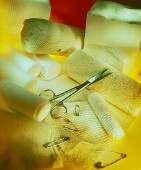- Navigating Your Midlife Crisis: Embracing New Possibilities
- City Raccoons Showing Signs of Domestication
- Mapping the Exposome: Science Broadens Focus to Environmental Disease Triggers
- One Week Less on Social Media Linked to Better Mental Health
- Your Brain Changes in Stages as You Age, Study Finds
- Some Suicide Victims Show No Typical Warning Signs, Study Finds
- ByHeart Formula Faces Lawsuits After Babies Sickened With Botulism
- Switch to Vegan Diet Could Cut Your Greenhouse Gas Emissions in Half
- Regular Bedtime Does Wonders for Blood Pressure
- Dining Alone Could Mean Worse Nutrition for Seniors
Recovery From Bunion Surgery Faster Than in Past


Improvements in bunion surgery have led to faster and less painful recovery, according to foot doctors.
A bunion is a bump near the base of the big toe that is caused by the misalignment of bones in the foot. About two-thirds of American adults will develop a bunion at some point in their life, according to the American College of Foot and Ankle Surgeons (ACFAS).
Bunions can become inflamed and increasingly painful, especially if aggravated by tight footwear. Wearing shoes with a larger toe box can help, but surgery may be necessary if bunion pain is constant or interferes with the ability to work or do other activities.
“There is a common misunderstanding among patients considering bunion removal surgery that they won’t be able to walk for weeks or months,” Dr. Alan Catanzariti, a Pittsburgh-based foot and ankle surgeon, said in an ACFAS news release.
“The reality is that the surgery has changed dramatically in the last 10 years, and recovery time is often four to six weeks,” he said.
Following surgery, most people can walk on their own if they use a special surgical shoe or walking boot. And most people recover fully from surgery in six weeks, according to researchers who presented findings recently at the ACFAS annual meeting in Phoenix. Findings presented at meetings are generally viewed as preliminary until published in a peer-reviewed journal.
“Bunion surgeries have been performed for more than 100 years. Techniques used today ensure minimal pain, earlier and improved mobility, and decrease the likelihood that a bunion will return later in life,” Dr. Luke Cicchinelli, an Arizona foot and ankle surgeon, said in the news release.
“As long as people are realistic about the shoes they’re wearing post-surgery, there is minimal chance that a bunion will return,” Cicchinelli added.
More information
The U.S. National Library of Medicine has more about bunions.
Source: HealthDay
Copyright © 2025 HealthDay. All rights reserved.










